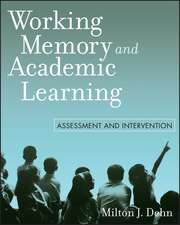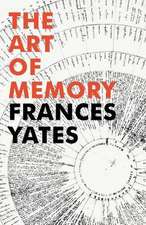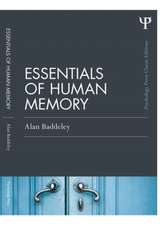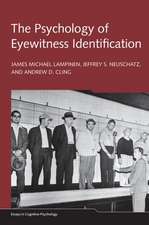Working Memory: Loss and reconstruction: Essays in Cognitive Psychology
Autor Pierre Barrouillet, Valérie Camosen Limba Engleză Paperback – 24 sep 2014
Tracing back the evolution of the concept of working memory, from its introduction by Baddeley and Hitch in 1974 and the development of their modal model, Barrouillet and Camos explain how an alternative conception could have been developed from the very beginning, and why it is needed today. This alternative model takes into account the temporal dynamics of mental functioning. The book describes a new architecture for working memory, and provides a description of its functioning, its development, the sources of individual differences, and hints about neural substrates. The authors address central and debated questions about working memory, and also more general issues about cognitive architecture and functioning.
Working Memory: Loss and Reconstruction will be essential reading for advanced students and researchers of the psychology of memory.
| Toate formatele și edițiile | Preț | Express |
|---|---|---|
| Paperback (1) | 423.28 lei 6-8 săpt. | |
| Taylor & Francis – 24 sep 2014 | 423.28 lei 6-8 săpt. | |
| Hardback (1) | 1164.44 lei 6-8 săpt. | |
| Taylor & Francis – 23 sep 2014 | 1164.44 lei 6-8 săpt. |
Din seria Essays in Cognitive Psychology
-
 Preț: 386.42 lei
Preț: 386.42 lei - 13%
 Preț: 348.02 lei
Preț: 348.02 lei -
 Preț: 461.50 lei
Preț: 461.50 lei -
 Preț: 467.44 lei
Preț: 467.44 lei -
 Preț: 459.71 lei
Preț: 459.71 lei - 22%
 Preț: 369.82 lei
Preț: 369.82 lei -
 Preț: 410.88 lei
Preț: 410.88 lei - 15%
 Preț: 541.72 lei
Preț: 541.72 lei - 18%
 Preț: 998.88 lei
Preț: 998.88 lei - 13%
 Preț: 302.64 lei
Preț: 302.64 lei -
 Preț: 482.53 lei
Preț: 482.53 lei -
 Preț: 480.62 lei
Preț: 480.62 lei -
 Preț: 482.94 lei
Preț: 482.94 lei - 48%
 Preț: 233.06 lei
Preț: 233.06 lei -
 Preț: 462.60 lei
Preț: 462.60 lei - 42%
 Preț: 233.06 lei
Preț: 233.06 lei - 18%
 Preț: 1000.27 lei
Preț: 1000.27 lei -
 Preț: 393.63 lei
Preț: 393.63 lei - 41%
 Preț: 236.05 lei
Preț: 236.05 lei -
 Preț: 482.35 lei
Preț: 482.35 lei - 26%
 Preț: 765.23 lei
Preț: 765.23 lei -
 Preț: 460.69 lei
Preț: 460.69 lei -
 Preț: 343.77 lei
Preț: 343.77 lei -
 Preț: 314.59 lei
Preț: 314.59 lei -
 Preț: 190.51 lei
Preț: 190.51 lei - 18%
 Preț: 1013.72 lei
Preț: 1013.72 lei - 17%
 Preț: 126.66 lei
Preț: 126.66 lei -
 Preț: 482.53 lei
Preț: 482.53 lei -
 Preț: 483.49 lei
Preț: 483.49 lei - 16%
 Preț: 130.21 lei
Preț: 130.21 lei -
 Preț: 465.39 lei
Preț: 465.39 lei - 31%
 Preț: 765.45 lei
Preț: 765.45 lei -
 Preț: 483.49 lei
Preț: 483.49 lei
Preț: 423.28 lei
Preț vechi: 497.97 lei
-15% Nou
Puncte Express: 635
Preț estimativ în valută:
80.99€ • 84.56$ • 67.03£
80.99€ • 84.56$ • 67.03£
Carte tipărită la comandă
Livrare economică 04-18 aprilie
Preluare comenzi: 021 569.72.76
Specificații
ISBN-13: 9781848722668
ISBN-10: 1848722664
Pagini: 240
Ilustrații: 28 black & white illustrations, 3 black & white tables, 28 black & white line drawings
Dimensiuni: 156 x 234 x 13 mm
Greutate: 0.35 kg
Ediția:New.
Editura: Taylor & Francis
Colecția Psychology Press
Seria Essays in Cognitive Psychology
Locul publicării:Oxford, United Kingdom
ISBN-10: 1848722664
Pagini: 240
Ilustrații: 28 black & white illustrations, 3 black & white tables, 28 black & white line drawings
Dimensiuni: 156 x 234 x 13 mm
Greutate: 0.35 kg
Ediția:New.
Editura: Taylor & Francis
Colecția Psychology Press
Seria Essays in Cognitive Psychology
Locul publicării:Oxford, United Kingdom
Cuprins
1. What is working memory? 2. Time and working memory 3. Time-based resource sharing 4. Working memory loss 5. Working memory reconstruction 6. A working memory architecture 7. Working memory in development and individual differences 8. Controversies and prospects in working memory Epilogue: Searching for working memory
Recenzii
'One of the central questions within current cognitive psychology concerns the puzzle of how an apparently simple measure, working memory span, is able to predict performance across a wide range of areas from language comprehension to attentional control, rivalling conventional intelligence tests in its predictive breadth and capacity. Barrouillet and Camos describe an extensive series of studies focused on this issue. They were the first to demonstrate that measures of working memory span do not require complex subtasks such as language comprehension and arithmetic processing, but can be obtained based extremely simple operations, provided these are made continuous, allowing no opportunity for participants to insert even brief periods of rehearsal. They develop their Time Based Resource Sharing (TBRS) model to account for these results, postulating the need for temporary storage which in turn requires attentional refreshing if the relevant memory trace is not to fade. They place their work in a broad historic context, argue cogently for their concept of decay rather than the more popular proposal of forgetting through interference, going on to apply their approach across a wide range of situations and populations. Their work makes an important contribution to a topic of central importance. This book does a service to the field in summarising their extensive research program, presenting it clearly, and comparing it with alternative interpretations. This book should certainly be on the shelves of anyone interested in individual differences in cognition and their basis in working memory.' – Alan Baddeley, Department of Psychology, University of York, UK
'In this era of brain images, one might assume that there is little left to learn using the primary tool that has been available to researchers of cognition for the past half-century: computers that can present visual and acoustic events and can record the speed and accuracy of human responses to these events. This assumption would be quite wrong for a number of topics, including the present topic of working memory. It is the small amount of information one can hold in mind to allow ideas to be constructed, language to be understood, problems to be solved, and intelligent actions to be carried out, and it improves as children develop. Barrouillet and Camos document this exciting, ongoing field of research in which incredible new discoveries are being made at a rapid rate: discoveries related to how long humans can hold a thought in mind, how many thoughts can co-exist, how they can be shielded from loss or reconstructed from memory, and how new concepts can be constructed from old ones. This rapidly-advancing field still hosts controversies about basic mechanisms of the mind, comparable to how physics hosts controversies about elementary particles. The authors are at the forefront of the working memory debate because of their own ground-breaking research, well-explained in this book that represents various views well and yet is an effective advocate for the authors’ own comprehensive view. Readers get a historical perspective and are also taken to current research battlefronts in an organized, engaging, succinct, and easy-to-read summary.' - Nelson Cowan, Department of Psychological Sciences, University of Missouri-Columbia, USA
'The Time-Based Resource-Sharing (TBRS) model takes a promising approach to understanding the mechanisms of working memory. It not only helps explain a wide range of key phenomena in this field but also provides predictions and directions for on-going working memory research. This sophisticated framework captures the temporal dynamics of working memory function quite nicely, as well as its development and inter-individual variations. This book commences with a comprehensive review of short-term and working memory research based on various historical and theoretical considerations, followed by a detailed presentation of the TBRS model and the introduction of some novel concepts. While the contents of this book are easily accessible and appealing to postgraduate students, active researchers in the field of human memory will also find the contents stimulating, as the issues covered in this volume are at the theoretical vanguard and include hot, up-to-date debates in the field.' – Satoru Saito, Associate Professor, Department of Cognitive Psychology in Education, Kyoto University, Japan
'Specialists in working memory and attention will be grateful for the detail with which the authors explain the studies they believe are central support for their viewpoint. ... Barrouillet and Casmos's willingness to reconsider ideas that have guided decades of research is critical to our field's forward progress. ... Barrouillet and Camos invite us to consider the road less traveled by. This invitation promises us the chance to move our understanding of working memory forward.' – Kristi S. Multhaup and Blaire J. Weidler, PsycCRITIQUES, 2015
'Barrouillet and Camos develop an argument for their own model of working memory [...] Barrouillet and Camos demonstrate a tremendous grasp of the extant research literature on working memory.' -K.S. Millar, Earlham College
'In this era of brain images, one might assume that there is little left to learn using the primary tool that has been available to researchers of cognition for the past half-century: computers that can present visual and acoustic events and can record the speed and accuracy of human responses to these events. This assumption would be quite wrong for a number of topics, including the present topic of working memory. It is the small amount of information one can hold in mind to allow ideas to be constructed, language to be understood, problems to be solved, and intelligent actions to be carried out, and it improves as children develop. Barrouillet and Camos document this exciting, ongoing field of research in which incredible new discoveries are being made at a rapid rate: discoveries related to how long humans can hold a thought in mind, how many thoughts can co-exist, how they can be shielded from loss or reconstructed from memory, and how new concepts can be constructed from old ones. This rapidly-advancing field still hosts controversies about basic mechanisms of the mind, comparable to how physics hosts controversies about elementary particles. The authors are at the forefront of the working memory debate because of their own ground-breaking research, well-explained in this book that represents various views well and yet is an effective advocate for the authors’ own comprehensive view. Readers get a historical perspective and are also taken to current research battlefronts in an organized, engaging, succinct, and easy-to-read summary.' - Nelson Cowan, Department of Psychological Sciences, University of Missouri-Columbia, USA
'The Time-Based Resource-Sharing (TBRS) model takes a promising approach to understanding the mechanisms of working memory. It not only helps explain a wide range of key phenomena in this field but also provides predictions and directions for on-going working memory research. This sophisticated framework captures the temporal dynamics of working memory function quite nicely, as well as its development and inter-individual variations. This book commences with a comprehensive review of short-term and working memory research based on various historical and theoretical considerations, followed by a detailed presentation of the TBRS model and the introduction of some novel concepts. While the contents of this book are easily accessible and appealing to postgraduate students, active researchers in the field of human memory will also find the contents stimulating, as the issues covered in this volume are at the theoretical vanguard and include hot, up-to-date debates in the field.' – Satoru Saito, Associate Professor, Department of Cognitive Psychology in Education, Kyoto University, Japan
'Specialists in working memory and attention will be grateful for the detail with which the authors explain the studies they believe are central support for their viewpoint. ... Barrouillet and Casmos's willingness to reconsider ideas that have guided decades of research is critical to our field's forward progress. ... Barrouillet and Camos invite us to consider the road less traveled by. This invitation promises us the chance to move our understanding of working memory forward.' – Kristi S. Multhaup and Blaire J. Weidler, PsycCRITIQUES, 2015
'Barrouillet and Camos develop an argument for their own model of working memory [...] Barrouillet and Camos demonstrate a tremendous grasp of the extant research literature on working memory.' -K.S. Millar, Earlham College
Descriere
The book presents a synthesis and a critical review of the past and present literature about working memory. It provides the first presentation of a new theory of working memory, the Time-Based Resource-Sharing (TBRS) model, and shows its application to several areas of cognition. Working Memory: Loss and Reconstruction will be essential reading for advanced students and researchers of the psychology of memory.











